Genome-Wide Identification and Expression Profile Analysis of the Phospholipase C Gene Family in Wheat (Triticum aestivum L.)
Abstract
:1. Introduction
2. Results
2.1. Identification and Analysis of Phospholipase C (PLC) Gene Family Members in Wheat
2.2. Exon–Intron Structure and Conserved Motifs of TaPLC Genes
2.3. Phylogenetic Analysis of TaPLC Genes
2.4. Chromosome Localization, Gene Duplication, and Collinearity Analysis of TaPLC Genes
2.5. Cis-Regulatory Elements in the Promoters of Wheat PLC Genes
2.6. Expression Patterns of TaPLC Genes in Different Tissues, Organs, and Stresses
2.7. Expression Profiles of TaPLCs in Leaves under Abiotic Stress
2.8. Overexpression of TaPI-PLC1-2B Enhanced Abiotic Stress Resistance in Arabidopsis Transgenic Plants
3. Discussion
4. Materials and Methods
4.1. Identification of PLC Family Members in the Wheat Genome
4.2. Sequence Analysis and Structural Characterization of PLC Genes/Proteins in Wheat
4.3. Phylogenetic Distribution, Chromosome Location, and Gene Duplication Analyses
4.4. Analysis of Cis-Acting Elements in TaPLC Genes’ Promoters
4.5. RNA-Sequencing (RNA-seq) Data Analysis of PLC Genes
4.6. Plant Materials and Abiotic Stress Treatments
4.7. Total RNA Extraction and Expression Analyses of Wheat PLC Genes
4.8. Generation of Transgenic Plants
5. Conclusions
Supplementary Materials
Author Contributions
Funding
Conflicts of Interest
References
- Boss, W.F.; Im, Y.J. Phosphoinositide signaling. Annu. Rev. Plant Biol. 2012, 63, 409–429. [Google Scholar] [CrossRef]
- Bhati, K.K.; Aggarwal, S.; Sharma, S.; Mantri, S.; Singh, S.P.; Bhalla, S.; Kaur, J.; Tiwari, S.; Roy, J.K.; Tuli, R.; et al. Differential expression of structural genes for the late phase of phytic acid biosynthesis in developing seeds of wheat (Triticum aestivum L.). Plant Sci. 2014, 224, 74–85. [Google Scholar] [CrossRef] [PubMed]
- Zhang, B.; Wang, Y.; Liu, J.Y. Genome-wide identification and characterization of phospholipase C gene family in cotton (Gossypium spp.). Sci. China Life Sci. 2018, 61, 88–99. [Google Scholar] [CrossRef]
- Hong, Y.; Zhao, J.; Guo, L.; Kim, S.C.; Deng, X.; Wang, G.; Zhang, G.; Li, M.; Wang, X. Plant phospholipases D and C and their diverse functions in stress responses. Prog. Lipid Res. 2016, 62, 55–74. [Google Scholar] [CrossRef] [Green Version]
- Singh, A.; Kanwar, P.; Pandey, A.; Tyagi, A.K.; Sopory, S.K.; Kapoor, S.; Pandey, G.K. Comprehensive genomic analysis and expression profiling of phospholipase C gene family during abiotic stresses and development in rice. PLoS ONE 2013, 8, e62494. [Google Scholar] [CrossRef] [PubMed] [Green Version]
- Pokotylo, I.; Kolesnikov, Y.; Kravets, V.; Zachowski, A.; Ruelland, E. Plant phosphoinositide-dependent phospholipases C: Variations around a canonical theme. Biochimie 2014, 96, 144–157. [Google Scholar] [CrossRef] [PubMed]
- Rupwate, S.D.; Rajasekharan, R. Plant phosphoinositide-specific phospholipase C: An insight. Plant Signal. Behav. 2012, 7, 1281–1283. [Google Scholar] [CrossRef] [PubMed] [Green Version]
- Aggarwal, S.; Shukla, V.; Bhati, K.K.; Kaur, M.; Sharma, S.; Singh, A.; Mantri, S.; Pandey, A.K. Hormonal Regulation and Expression Profiles of Wheat Genes Involved during Phytic Acid Biosynthesis Pathway. Plants 2015, 4, 298–319. [Google Scholar] [CrossRef] [Green Version]
- Peters, C.; Li, M.; Narasimhan, R.; Roth, M.; Welti, R.; Wang, X. Nonspecific phospholipase C NPC4 promotes responses to abscisic acid and tolerance to hyperosmotic stress in Arabidopsis. Plant Cell 2010, 22, 2642–2659. [Google Scholar] [CrossRef] [Green Version]
- Song, J.; Zhou, Y.; Zhang, J.; Zhang, K. Structural, expression and evolutionary analysis of the non-specific phospholipase C gene family in Gossypium hirsutum. BMC Genom. 2017, 18, 979. [Google Scholar] [CrossRef] [Green Version]
- Molano, E.P.L.; Cabrera, O.G.; José, J.; Nascimento, L.C.D.; Carazzolle, M.F.; Teixeira, P.J.; Álvarez, J.; Tiburcio, R.A.; Filho, P.M.T.; Lima, G.; et al. Ceratocystis cacaofunesta genome analysis reveals a large expansion of extracellular phosphatidylinositol-specific phospholipase-C genes (PI-PLC). BMC Genom. 2018, 19, 58. [Google Scholar] [CrossRef] [PubMed]
- Pokotylo, I.; Pejchar, P.; Potocky, M.; Kocourkova, D.; Krckova, Z.; Ruelland, E.; Kravets, V.; Martinec, J. The plant non-specific phospholipase C gene family. Novel competitors in lipid signalling. Prog. Lipid Res. 2013, 52, 62–79. [Google Scholar] [CrossRef] [PubMed]
- Munnik, T.; Testerink, C. Plant phospholipid signaling: “In a nutshell”. J. Lipid Res. 2009, 50, S260–S265. [Google Scholar] [CrossRef] [Green Version]
- Apostolakos, P.; Panteris, E.; Galatis, B. The involvement of phospholipases C and D in the asymmetric division of subsidiary cell mother cells of Zea mays. Cell. Motil. Cytoskeleton 2008, 65, 863–875. [Google Scholar] [CrossRef] [PubMed]
- Wang, F.; Deng, Y.; Zhou, Y.; Dong, J.; Chen, H.; Dong, Y.; Wang, N.; Li, X.; Li, H. Genome-Wide Analysis and Expression Profiling of the Phospholipase C Gene Family in Soybean (Glycine max). PLoS ONE 2015, 10, e0138467. [Google Scholar] [CrossRef] [PubMed] [Green Version]
- Song, F. Molecular cloning and characterization of a rice phosphoinositide-specific phospholipase C gene, OsPI-PLC1, that is activated in systemic acquired resistance. Physiol. Mol. Plant Pathol. 2002, 61, 31–40. [Google Scholar]
- Takahashi, S.; Katagiri, T.; Hirayama, T.; Shinozaki, K. Hyperosmotic Stress Induces a Rapid and Transient Increase in Inositol 1,4,5-Trisphosphate Independent of Abscisic Acid in Arabidopsis Cell Culture. Plant Cell Physiol. 2001, 42, 214–222. [Google Scholar] [CrossRef] [PubMed] [Green Version]
- Kanehara, K.; Yu, C.Y.; Cho, Y.; Cheong, W.F.; Torta, F.; Shui, G.; Wenk, M.R.; Nakamura, Y. Arabidopsis AtPLC2 Is a Primary Phosphoinositide-Specific Phospholipase C in Phosphoinositide Metabolism and the Endoplasmic Reticulum Stress Response. PLoS Genet. 2015, 11, e1005511. [Google Scholar] [CrossRef] [PubMed] [Green Version]
- Li, L.; He, Y.; Wang, Y.; Zhao, S.; Chen, X.; Ye, T.; Wu, Y. Arabidopsis PLC2 is involved in auxin-modulated reproductive development. Plant J. 2015, 84, 504–515. [Google Scholar] [CrossRef] [Green Version]
- Zheng, S.Z.; Liu, Y.L.; Li, B.; Shang, Z.L.; Zhou, R.G.; Sun, D.Y. Phosphoinositide-specific phospholipase C9 is involved in the thermotolerance of Arabidopsis. Plant J. 2012, 69, 689–700. [Google Scholar] [CrossRef]
- Gao, K.; Liu, Y.L.; Li, B.; Zhou, R.G.; Sun, D.Y.; Zheng, S.Z. Arabidopsis thaliana phosphoinositide-specific phospholipase C isoform 3 (AtPLC3) and AtPLC9 have an additive effect on thermotolerance. Plant Cell Physiol. 2014, 55, 1873–1883. [Google Scholar] [CrossRef] [PubMed] [Green Version]
- Zhang, J.; Xia, K.; Yang, Y.; Yang, H. Overexpression of Arabidopsis phosphoinositide-specific phospholipase C5 induces leaf senescence. Plant Cell Tissue Organ Cult. (PCTOC) 2014, 120, 585–595. [Google Scholar] [CrossRef]
- Munnik, T.; Vermeer, J.E. Osmotic stress-induced phosphoinositide and inositol phosphate signalling in plants. Plant Cell Environ. 2010, 33, 655–669. [Google Scholar] [CrossRef] [PubMed]
- Chua, N.H.; Sanchez, J.P. Arabidopsis PLC1 Is Required for Secondary Responses to Abscisic Acid Signals. Plant Cell 2001, 13, 1143–1154. [Google Scholar] [CrossRef] [Green Version]
- Nokhrina, K.; Ray, H.; Bock, C.; Georges, F. Metabolomic shifts in Brassica napus lines with enhanced BnPLC2 expression impact their response to low temperature stress and plant pathogens. GM Crops Food 2014, 5, 120–131. [Google Scholar] [CrossRef] [Green Version]
- Das, S.; Hussain, A.; Bock, C.; Keller, W.A.; Georges, F. Cloning of Brassica napus phospholipase C2 (BnPLC2), phosphatidylinositol 3-kinase (BnVPS34) and phosphatidylinositol synthase1 (BnPtdIns S1)—Comparative analysis of the effect of abiotic stresses on the expression of phosphatidylinositol signal transduction-related genes in B. napus. Planta 2005, 220, 777–784. [Google Scholar] [CrossRef]
- Apone, F.; Alyeshmerni, N.; Wiens, K.; Chalmers, D.; Chrispeels, M.J.; Colucci, G. The G-protein-coupled receptor GCR1 regulates DNA synthesis through activation of phosphatidylinositol-specific phospholipase C. Plant Physiol. 2003, 133, 571–579. [Google Scholar] [CrossRef] [PubMed] [Green Version]
- Zhang, K.; Jin, C.; Wu, L.; Hou, M.; Dou, S.; Pan, Y.J. Expression Analysis of a Stress-Related Phosphoinositide-Specific Phospholipase C Gene in Wheat (Triticum aestivum L.). PLoS ONE 2014, 9, e105061. [Google Scholar] [CrossRef]
- Song, M.; Liu, S.; Zhou, Z.; Han, Y. TfPLC1, a gene encoding phosphoinositide-specific phospholipase C, is predominantly expressed in reproductive organs in Torenia fournieri. Sex. Plant Reprod. 2008, 21, 259–267. [Google Scholar] [CrossRef]
- Pan, Y.Y.; Wang, X.; Ma, L.G.; Sun, D.Y. Characterization of phosphatidylinositol-specific phospholipase C (PI-PLC) from Lilium daviddi pollen. Plant Cell Physiol. 2005, 46, 1657–1665. [Google Scholar] [CrossRef]
- Lin, W.H.; Ye, R.; Ma, H.; Xu, Z.H.; Xue, H.W. DNA chip-based expression profile analysis indicates involvement of the phosphatidylinositol signaling pathway in multiple plant responses to hormone and abiotic treatments. Cell Res. 2004, 1, 38–49. [Google Scholar] [CrossRef] [PubMed]
- Guo, X.J.; Wang, J.R. Global identification, structural analysis and expression characterization of bHLH transcription factors in wheat. BMC Plant Biol. 2017, 17, 90–102. [Google Scholar] [CrossRef] [Green Version]
- Michael, A.; Jane, R.; Thomas, L.; Raphaël, F.; Françoise, A.; Cyril, P.; Nacer, M.; Sophie, D.; Erik, K. Linking the International Wheat Genome Sequencing Consortium bread wheat reference genome sequence to wheat genetic and phenomic data. Genome Biol. 2018, 19, 111. [Google Scholar] [CrossRef]
- Panchy, N.; Lehti-Shiu, M.D.; Shiu, S.H. Evolution of gene duplication in plants. Plant Physiol. 2016, 00523–02016. [Google Scholar] [CrossRef] [Green Version]
- Tasma, I.M.; Brendel, V.; Whitham, S.A.; Bhattacharyya, M.K. Expression and evolution of the phosphoinositide-specific phospholipase C gene family in Arabidopsis thaliana. Plant Physiol. Biochem. 2008, 46, 627–637. [Google Scholar] [CrossRef]
- Kosová, K.; Vítámvás, P.; Prášil, I.T.; Renaut, J. Plant proteome changes under abiotic stress—Contribution of proteomics studies to understanding plant stress response. J. Proteom. 2011, 74, 1301–1322. [Google Scholar] [CrossRef]
- Gaude, N.; Nakamura, Y.; Scheible, W.R.; Ohta, H.; Dormann, P. Phospholipase C5 (NPC5) is involved in galactolipid accumulation during phosphate limitation in leaves of Arabidopsis. Plant J. 2008, 56, 28–39. [Google Scholar] [CrossRef]
- Shi, M.; Zhou, L.; Zhao, L.; Shang, M.; Huang, Y.J. Csseverin inhibits apoptosis through mitochondria-mediated pathways triggered by Ca2 + dyshomeostasis in hepatocarcinoma PLC cells. PLoS Negl. Trop. Dis. 2017, 11, e0006074. [Google Scholar] [CrossRef] [Green Version]
- Xia, L.; Liang, H.; Xu, L.; Chen, J.J. Subcellular localization and function study of a secreted phospholipase C from Nocardia seriolae. FEMS Microbiol. Lett. 2017, 364, 17. [Google Scholar] [CrossRef] [Green Version]
- Chen, J.; Zheng, D.; Cui, H.; Liu, S.; Zhang, L.; Liu, C.J. Roles and mechanisms of TRPC3 and the PLCγ/PKC/CPI-17 signaling pathway in regulating parturition. Mol. Med. Rep. 2018, 17, 898–910. [Google Scholar] [CrossRef] [Green Version]
- Mahmud, H.; Scherpen, F.J.G.; Boer, T.M.D.; Lourens, H.J.; Bont, E.S. Peptide microarray profiling identifies phospholipase C gamma 1 (PLC-γ1) as a potential target for t (8;21) AML. Oncotarget 2017, 8, 67344–67354. [Google Scholar] [CrossRef] [PubMed] [Green Version]
- Choi, J.; Kim, K.S.; Rho, H.S.; Lee, Y.H. Differential roles of the phospholipase C genes in fungal development and pathogenicity of Magnaporthe oryzae. Fungal Genet. Biol. 2011, 48, 445–455. [Google Scholar] [CrossRef] [PubMed]
- Suzuki, M.; Tanaka, K.; Kuwano, M.; Yoshida, K.T. Expression pattern of inositol phosphate-related enzymes in rice (Oryza sativa L.): Implications for the phytic acid biosynthetic pathway. Gene 2007, 405, 55–64. [Google Scholar] [CrossRef]
- Wang, C.R.; Yang, A.F.; Yue, G.D.; Gao, Q.; Yin, H.Y.; Zhang, J.R. Enhanced expression of phospholipase C 1 (ZmPLC1) improves drought tolerance in transgenic maize. Planta 2008, 227, 1127–1140. [Google Scholar] [CrossRef] [PubMed]
- Gasteiger, E.; Hoogland, C.; Gattiker, A.; Duvaud, S.E.; Wilkins, M.R.; Appel, R.D.; Bairoch, A. Protein Identification and Analysis Tools on the ExPASy Server. In The Proteomics Protocols Handbook; Walker, J.M., Ed.; Humana Press: New York, NY, USA, 2005; pp. 571–607. [Google Scholar] [CrossRef]
- Bailey, T.L.; Mikael, B.; Buske, F.A.; Martin, F.; Grant, C.E.; Luca, C.; Ren, J.; Li, W.W.; Noble, W.S. MEME Suite: Tools for motif discovery and searching. Nucleic Acids Res. 2009, 37, W202–W208. [Google Scholar] [CrossRef] [PubMed]
- Zhang, H.; Gao, S.; Lercher, M.J.; Hu, S.; Chen, W.H. EvolView, an online tool for visualizing, annotating and managing phylogenetic trees. Nucleic Acids Res. 2012, 40, W569–W572. [Google Scholar] [CrossRef]
- Saitou, N.; Nei, M.J. Evolution: The neighbor-joining method: A new method for reconstructing phylogenetic trees. Mol Biol Evol. 1987, 4, 406–425. [Google Scholar] [CrossRef]
- Sudhir, K.; Glen, S.; Koichiro, T.J. Evolution: MEGA7: Molecular Evolutionary Genetics Analysis Version 7.0 for Bigger Datasets. Mol. Biol. Evol. 2016, 33, 1870–1874. [Google Scholar] [CrossRef] [Green Version]
- Zhao, P.; Wang, D.; Wang, R.; Kong, N.; Zhang, C.; Yang, C.; Wu, W.; Ma, H.; Chen, Q. Genome-wide analysis of the potato Hsp20 gene family: Identification, genomic organization and expression profiles in response to heat stress. BMC Genom. 2018, 19, 61. [Google Scholar] [CrossRef]
- Chen, C.; Xia, R.; Chen, H.; He, Y. TBtools, a toolkit for biologists integrating various HTS-data handling tools with a user-friendly interface. bioRxiv 2018. [Google Scholar] [CrossRef]
- Hu, B.; Jin, J.; Guo, A.Y.; Zhang, H.; Luo, J.; Gao, G. GSDS 2.0: An upgraded gene feature visualization server. Bioinformatics 2014, 31, 296–1297. [Google Scholar] [CrossRef] [PubMed] [Green Version]
- Han, Z.; Liu, Y.; Deng, X.; Liu, D.; Liu, Y.; Hu, Y.; Yan, Y. Genome-wide identification and expression analysis of expansin gene family in common wheat (Triticum aestivum L.). BMC Genom. 2019, 20, 101. [Google Scholar] [CrossRef] [PubMed]
- Xia, K.; Wang, B.; Zhang, J.; Li, Y.; Yang, H.; Ren, D. Arabidopsis phosphoinositide-specific phospholipase C 4 negatively regulates seedling salt tolerance. Plant Cell Environ. 2017, 40, 1317–1331. [Google Scholar] [CrossRef]
- Clough, S.J.; Bent, A.F. Floral dip: A simplified method for Agrobacterium-mediated transformation of Arabidopsis thaliana. Plant J. 1998, 16, 735–743. [Google Scholar] [CrossRef] [Green Version]
- Zhao, Y.; Ma, R.; Xu, D.; Bi, H.; Xia, Z.; Peng, H. Genome-Wide Identification and Analysis of the AP2 Transcription Factor Gene Family in Wheat (Triticum aestivum L.). Front. Plant Sci. 2019, 10, 1286. [Google Scholar] [CrossRef] [Green Version]


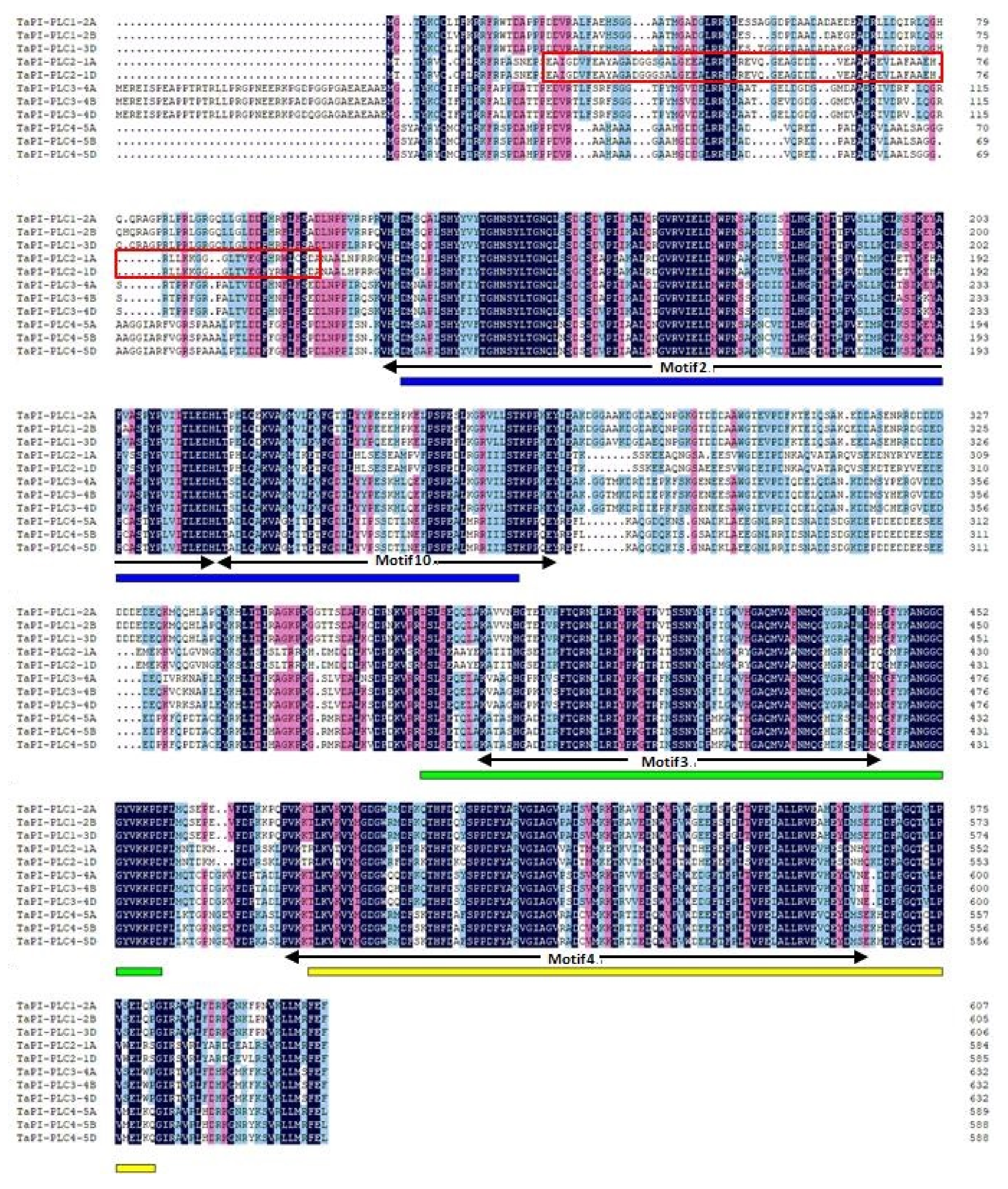
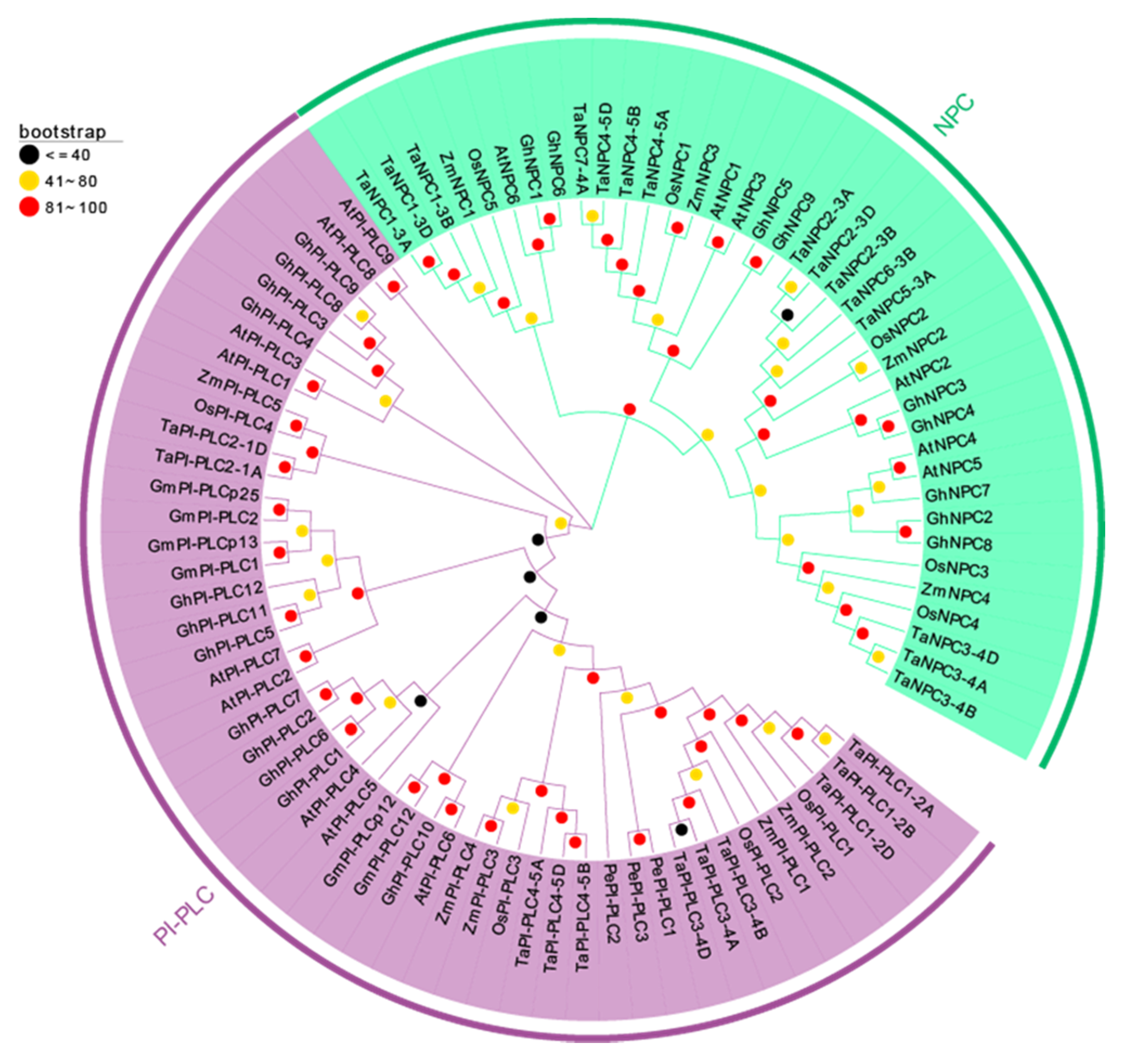
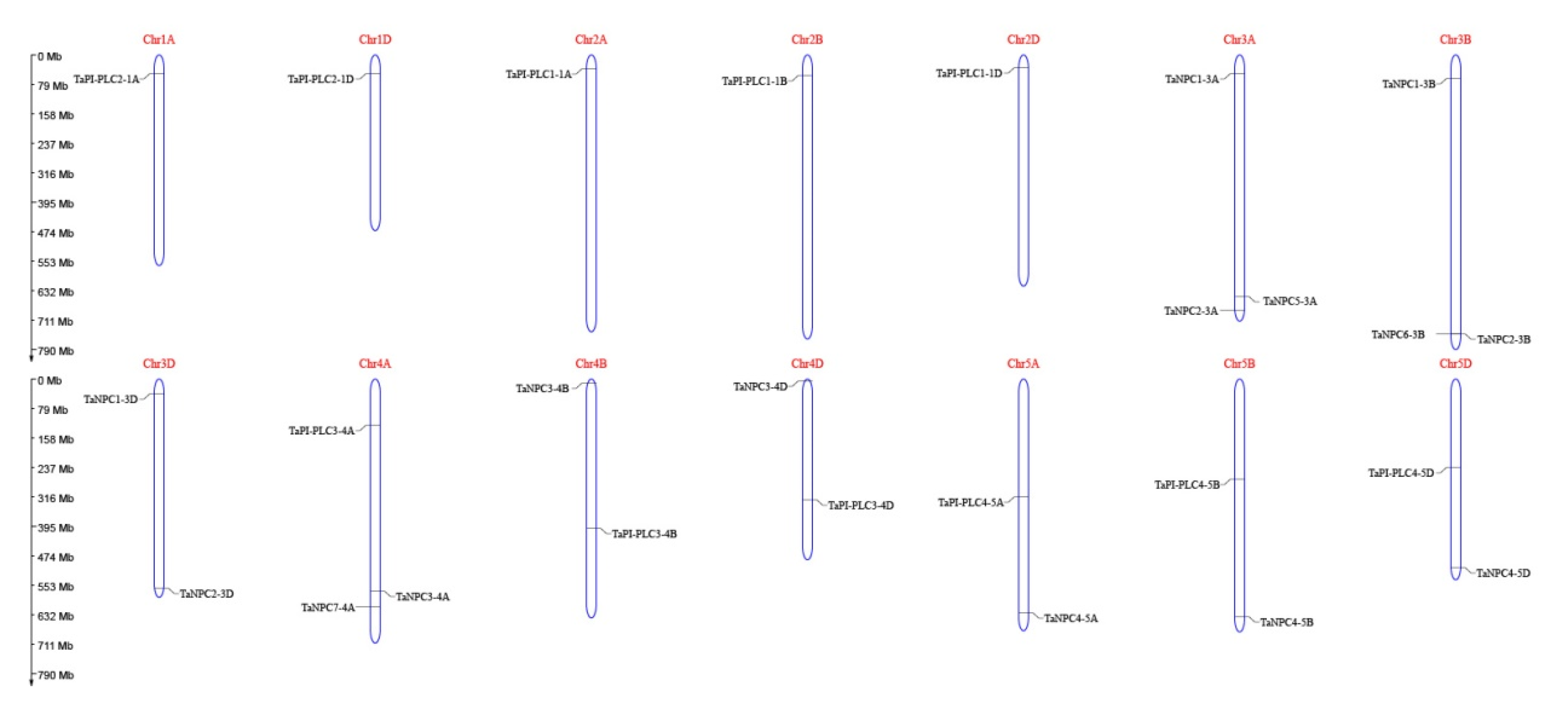


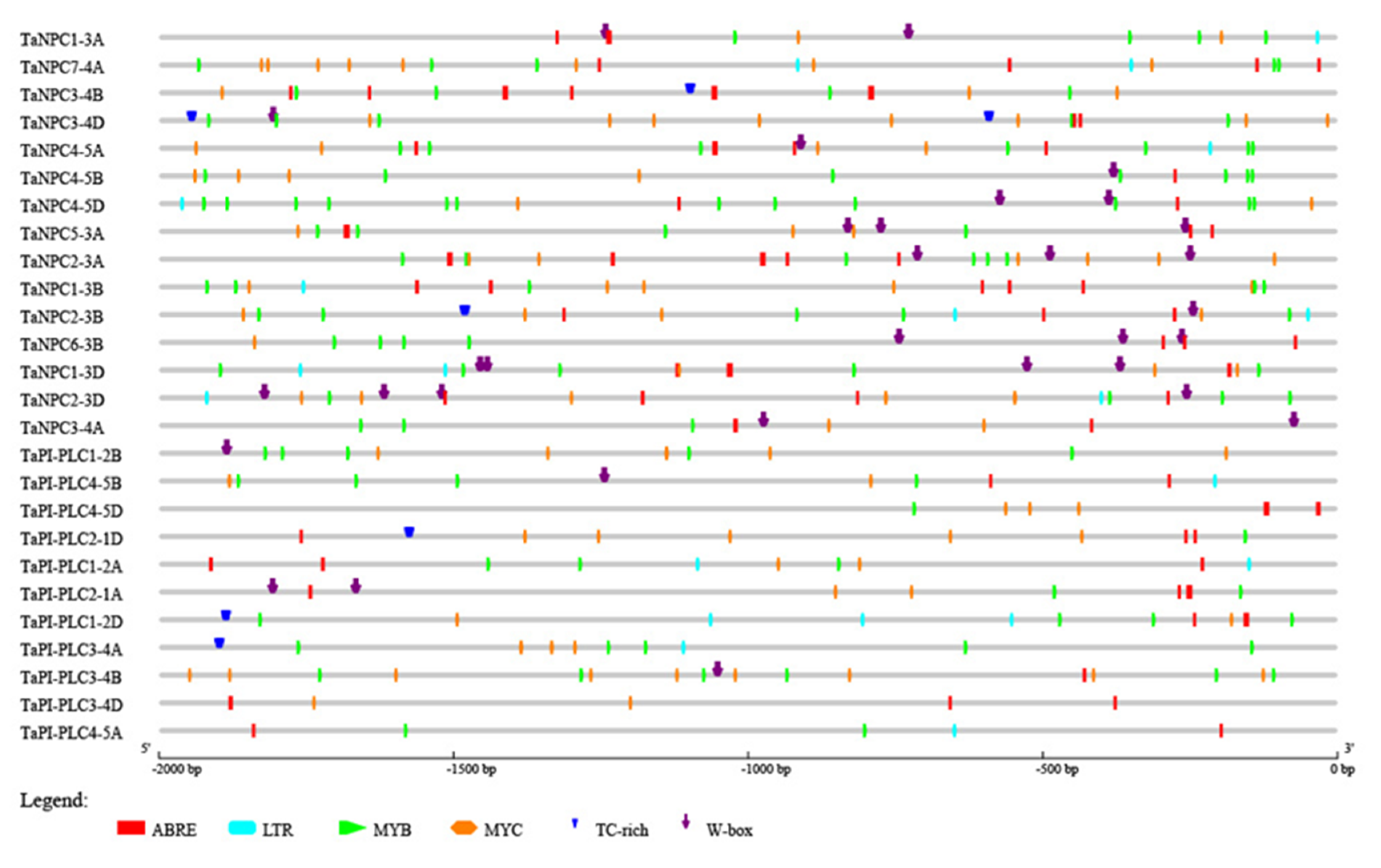
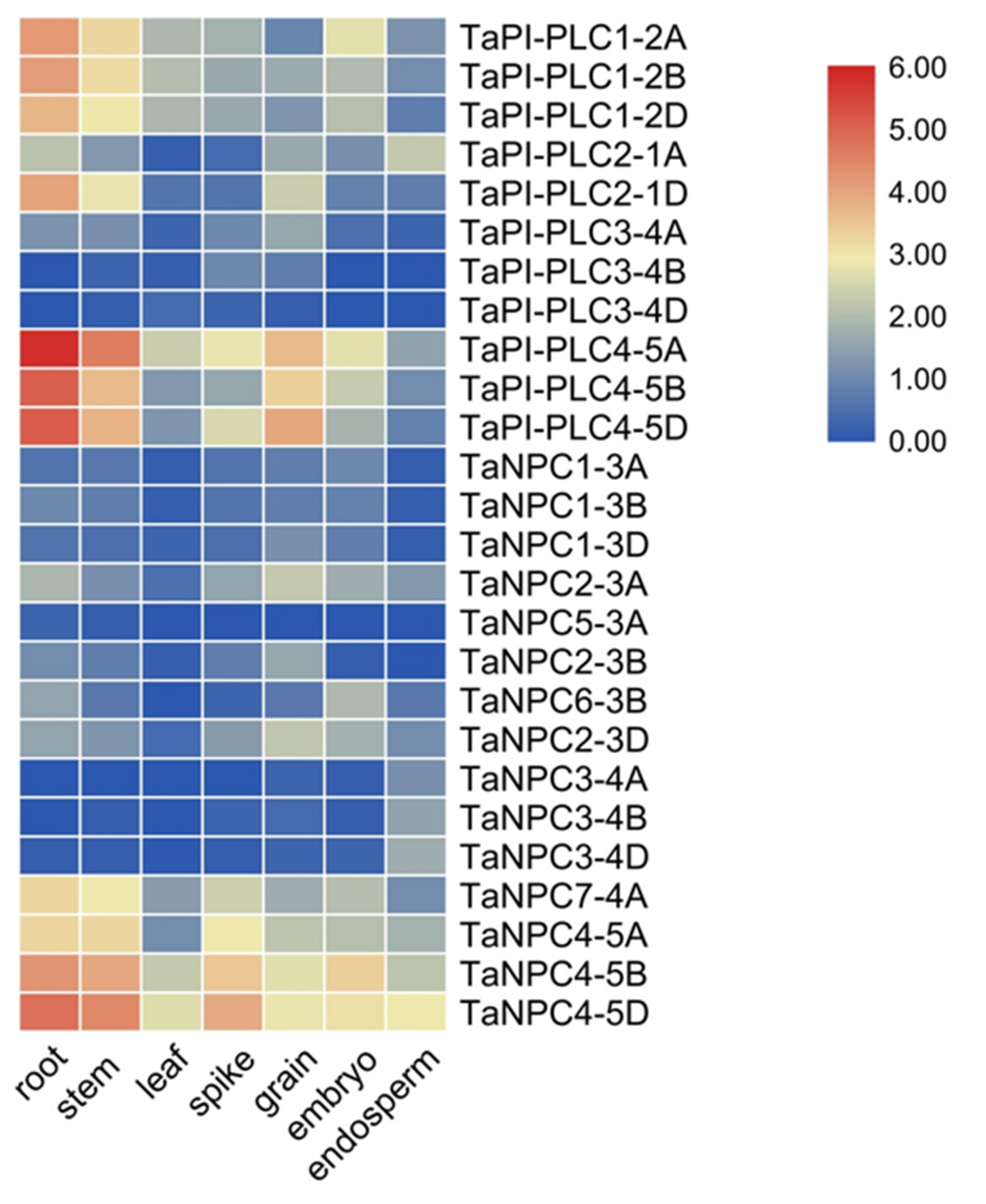
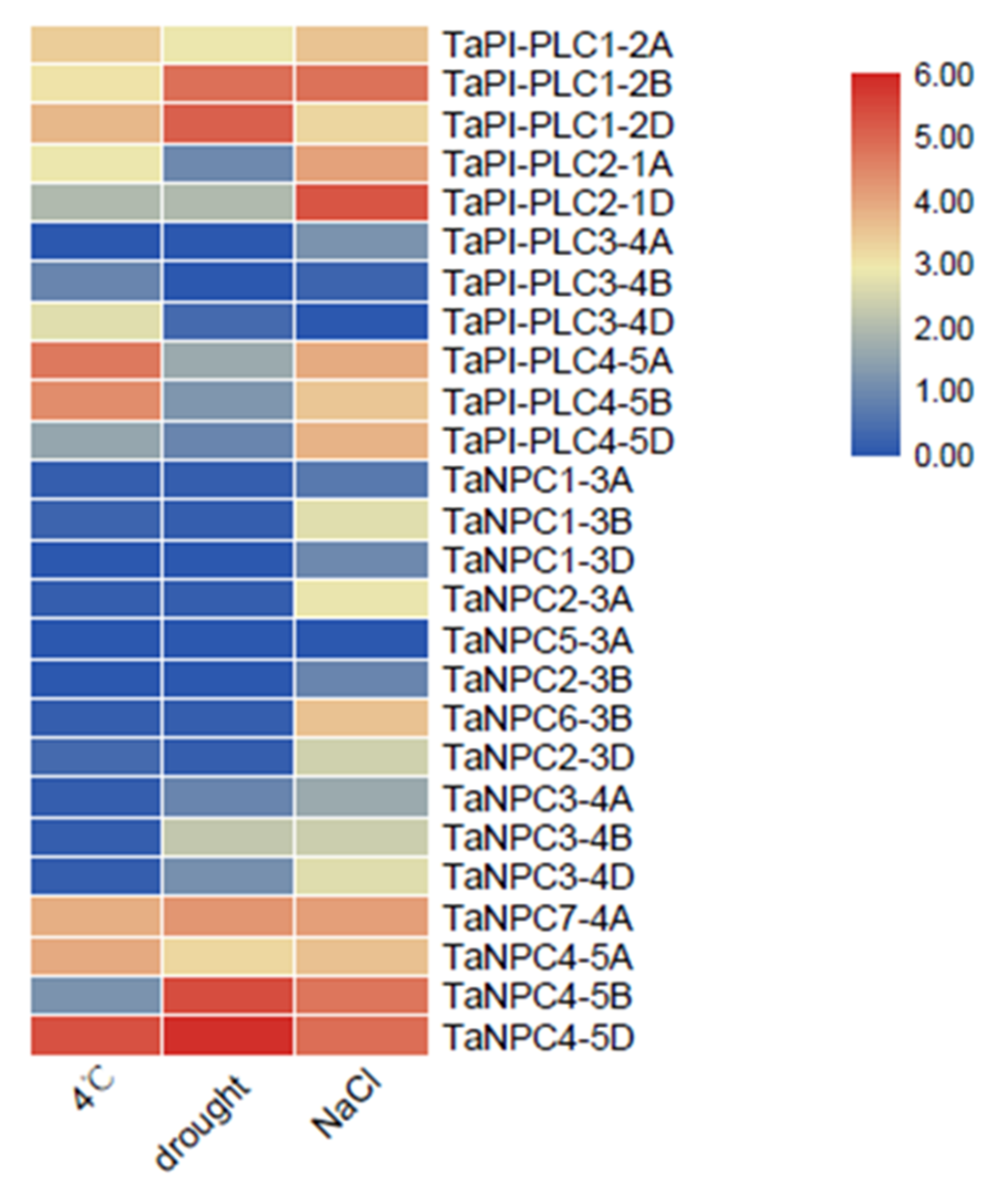


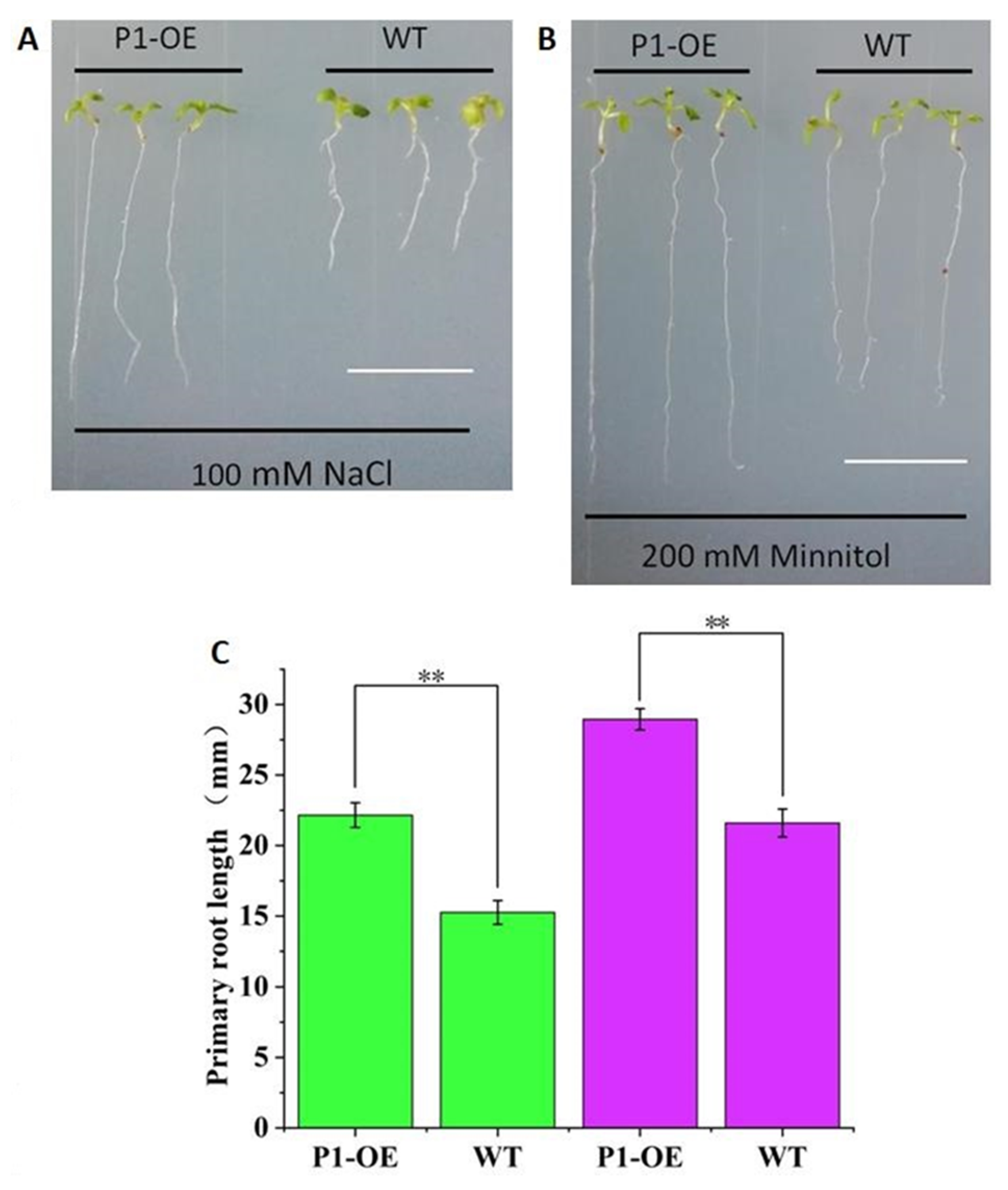
| Gene Name | Transcript ID | Family | Exon no. | Location | Protein (AA) | MW (kDa) | PI | GRAVY |
|---|---|---|---|---|---|---|---|---|
| TaPI-PLC1-2A | TraesCS2A02G084000 | PI-PLC | 8 | 2A:38534860-38538480 | 608 | 68.4 | 5.91 | −0.576 |
| TaPI-PLC1-2B | TraesCS2B02G098500 | PI-PLC | 8 | 2B:58321242-58325230 | 606 | 68.2 | 6.06 | −0.590 |
| TaPI-PLC2-2D | TraesCS2D02G082000 | PI-PLC | 8 | 2D:35259471-35263395 | 607 | 68.5 | 5.88 | −0.581 |
| TaPI-PLC2-1A | TraesCS1A02G069300 | PI-PLC | 9 | 1A:51700021-51707185 | 585 | 66.0 | 6.07 | −0.462 |
| TaPI-PLC1-1D | TraesCS1D02G071800 | PI-PLC | 9 | 1D:52338417-52345805 | 586 | 66.2 | 6.03 | −0.470 |
| TaPI-PLC3-4A | TraesCS4A02G109000 | PI-PLC | 9 | 4A:129086595-129090166 | 633 | 71.1 | 5.54 | −0.446 |
| TaPI-PLC3-4B | TraesCS4B02G195200 | PI-PLC | 9 | 4B:420197892-420201623 | 633 | 71.0 | 5.75 | −0.425 |
| TaPI-PLC3-4D | TraesCS4D02G195800 | PI-PLC | 9 | 4D:340085748-340090648 | 633 | 71.1 | 5.84 | −0.434 |
| TaPI-PLC4-5A | TraesCS5A02G155300 | PI-PLC | 9 | 5A:333407514-333413175 | 590 | 65.7 | 6.05 | −0.443 |
| TaPI-PLC4-5B | TraesCS5B02G153600 | PI-PLC | 9 | 5B:283008744-283014326 | 589 | 65.7 | 6.06 | −0.425 |
| TaPI-PLC4-5D | TraesCS5D02G160300 | PI-PLC | 9 | 5D:250061407-250066699 | 589 | 65.7 | 6.06 | −0.437 |
| TaNPC1-3A | TraesCS3A02G083200 | NPC | 2 | 3A:53559328-53561696 | 531 | 58.4 | 7.81 | −0.199 |
| TaNPC1-3B | TraesCS3B02G098100 | NPC | 2 | 3B:65552302-65554643 | 531 | 58.6 | 7.26 | −0.239 |
| TaNPC1-3D | TraesCS3D02G083000 | NPC | 2 | 3D:42093593-42095880 | 531 | 58.3 | 8.32 | −0.202 |
| TaNPC2-3A | TraesCS3A02G492100 | NPC | 4 | 3A:719301726-719305850 | 533 | 60.0 | 5.98 | −0.408 |
| TaNPC2-3B | TraesCS3B02G552800 | NPC | 4 | 3B:787478591-787485906 | 530 | 58.6 | 5.94 | −0.387 |
| TaNPC2-3D | TraesCS3D02G499600 | NPC | 4 | 3D:589374117-589378796 | 537 | 59.4 | 6.07 | −0.385 |
| TaNPC3-4A | TraesCS4A02G298300 | NPC | 2 | 4A:597023152-597025088 | 513 | 56.7 | 6.05 | −0.347 |
| TaNPC3-4B | TraesCS4B02G015300 | NPC | 2 | 4B:11567063-11569283 | 516 | 57.1 | 5.95 | −0.358 |
| TaNPC3-4D | TraesCS4D02G013500 | NPC | 2 | 4D:6291692-6293849 | 514 | 57.0 | 5.88 | −0.364 |
| TaNPC4-5A | TraesCS5A02G489800 | NPC | 3 | 5A:659456675-659460043 | 540 | 60.0 | 7.01 | −0.362 |
| TaNPC4-5B | TraesCS5B02G503200 | NPC | 3 | 5B:669895600-669898631 | 542 | 60.2 | 7.31 | −0.354 |
| TaNPC4-5D | TraesCS5D02G504100 | NPC | 3 | 5D:530645503-530649282 | 541 | 60.1 | 7.01 | −0.352 |
| TaNPC5-3A | TraesCS3A02G439600 | NPC | 3 | 3A:682746317-682754957 | 554 | 61.7 | 7.13 | −0.309 |
| TaNPC6-3B | TraesCS3B02G553200 | NPC | 4 | 3B:787850236-787854279 | 530 | 58.6 | 5.98 | −0.382 |
| TaNPC7-4A | TraesCS4A02G369500 | NPC | 3 | 4A:641504088-641508259 | 540 | 60.1 | 7.01 | −0.383 |
© 2020 by the authors. Licensee MDPI, Basel, Switzerland. This article is an open access article distributed under the terms and conditions of the Creative Commons Attribution (CC BY) license (http://creativecommons.org/licenses/by/4.0/).
Share and Cite
Wang, X.; Liu, Y.; Li, Z.; Gao, X.; Dong, J.; Zhang, J.; Zhang, L.; Thomashow, L.S.; Weller, D.M.; Yang, M. Genome-Wide Identification and Expression Profile Analysis of the Phospholipase C Gene Family in Wheat (Triticum aestivum L.). Plants 2020, 9, 885. https://doi.org/10.3390/plants9070885
Wang X, Liu Y, Li Z, Gao X, Dong J, Zhang J, Zhang L, Thomashow LS, Weller DM, Yang M. Genome-Wide Identification and Expression Profile Analysis of the Phospholipase C Gene Family in Wheat (Triticum aestivum L.). Plants. 2020; 9(7):885. https://doi.org/10.3390/plants9070885
Chicago/Turabian StyleWang, Xianguo, Yang Liu, Zheng Li, Xiang Gao, Jian Dong, Jiacheng Zhang, Longlong Zhang, Linda S. Thomashow, David M. Weller, and Mingming Yang. 2020. "Genome-Wide Identification and Expression Profile Analysis of the Phospholipase C Gene Family in Wheat (Triticum aestivum L.)" Plants 9, no. 7: 885. https://doi.org/10.3390/plants9070885





